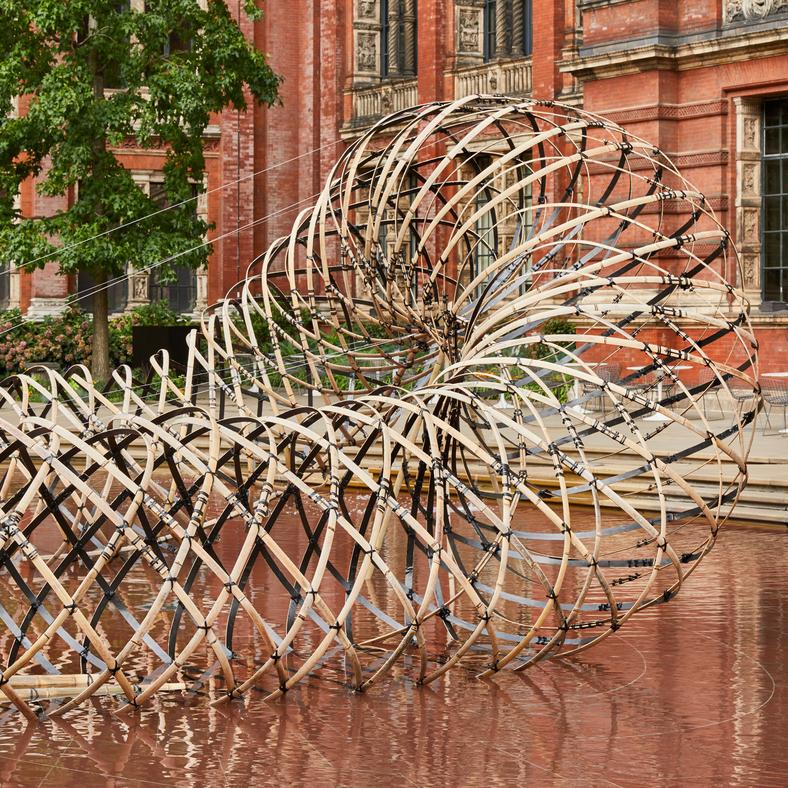Bamboo and carbon fibre are woven together to form a structure of rings that reverberates with the sound of music, in an innovative installation from Chinese consumer electronics manufacturer Oppo and Japanese architect Kengo Kuma.
'Bamboo (竹) Ring :|| Weaving a Symphony of Lightness and Form' was designed for display at this week's Milan Design Week 2021. It occupies the courtyard in Milan’s Cortile dei Bagni, where it will remain until 19 September.
It is an evolution of a 2019 installation that Kuma and Oppo collaborated on for London Design Festival. It was in this installation, ‘Bamboo (竹) Ring: Weaving into Lightness’, that Kuma first explored weaving together bamboo and carbon fibre to create a strong, earthquake-resistant material that reflected design principles also applied to the Japan National Stadium for the Tokyo 2020 Olympic Games.
The 2021 installation fuses Kuma's structural design with technology and classical music to evolve the rings into a musical instrument.
Oppo London Design Centre's research and development centre embedded technology within the structure—including new haptic motors, solid-state speaker strips, and exciters—to produce an immersive base and higher frequencies which reverberate the bamboo with Violin's vibrato and the effect of a percussion instrument.

The bamboo structure itself is vibrated to reproduce the sound of the violin, using exciter technology that turns surfaces and materials into sound sources—replacing the concept of traditional speakers. The sound produced is characterised by the material properties of bamboo.
Using new technologies originally developed by USound for mobile and wearable devices, microscopic solid state speakers are arranged in thin, flexible strips to produce vibrant and rich high frequencies.
Haptic motors used to generate vibrations in mobile phones and game controllers are able to produce haptic patterns based on sounds. In this installation Impact haptic technology from Nanoport Titan Haptics is used to hit the bamboo structure like a drum, recreating the effect of percussion instruments.
These technologies relay a score, composed and performed by Midori Komachi on her violin and inspired by the four seasons. The score (click here for a clip) is layered with sounds inspired by nature, developed in dialogue between the composer and Oppo for its digital wellbeing app O Relax.
Kuma said: "When I design architecture, I’m interested in designing the rhythm and the tone rather than the silhouette, and contemporary music gives us many lessons about how to create new rhythms and tones in architecture. This pavilion is one of the explorations into the new rhythms and tones in architecture combining visual and acoustic experiences of the visitors."
Jintong Zhu, head of Oppo London Design Centre, commented: "We are delighted to partner with Kengo Kuma again, an architect who is known for seamlessly integrating nature and culture. Together, we demonstrate how we can use technology and design to add value to our daily lives, drawing on our philosophy principles of ‘Technology as an Art Form’ and our brand mission ‘Technology for Mankind, Being Kind to the World'."
After Milan Design Week, Oppo will donate Bamboo Ring to Arte Sella Park in Trentino, Italy, a contemporary art museum with outdoor exhibits made from natural materials and backdropped by the mountainous Sella Valley.
| You've arrived at Inspiration Station, a weekly look at imaginative and artistic work from creators of all kinds across Asia-Pacific. Step off for a minute to recharge your creative batteries and find inspiration for that next big idea of yours further down the track. |
